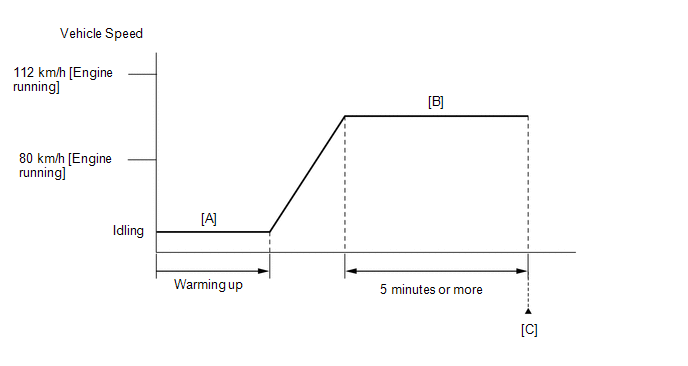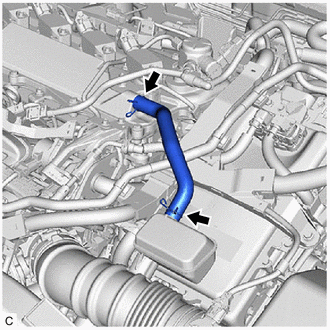DESCRIPTION Refer to DTC P010012. Click here
MONITOR DESCRIPTION The mass air flow meter sub-assembly is a sensor that measures the amount of air flowing through the throttle valve. The ECM uses this information to determine fuel injection timing and to provide an appropriate air fuel ratio. Inside the mass air flow meter sub-assembly, there is a heated platinum wire which is exposed to the flow of intake air. By applying a specific electrical current to the wire, the ECM heats it to a specific temperature. The flow of incoming air cools both the wire and an internal thermistor, affecting their resistance. To maintain a constant current value, the ECM varies the voltage applied to the mass air flow meter sub-assembly. The voltage level is proportional to the airflow through the sensor, and the ECM uses it to calculate the intake air volume. The ECM monitors the average engine load value ratio to check the mass air flow meter sub-assembly for malfunctions. The average engine load value ratio is obtained by comparing the average engine load calculated from the mass air flow meter sub-assembly output to the average engine load estimated from the driving conditions, such as the engine speed and the throttle opening angle. If the average engine load value ratio is below the threshold value, the ECM determines that the intake air volume is low, and if the average engine load value ratio is above the threshold value, the ECM determines that the intake air volume is high. If either of these conditions is detected in 2 consecutive driving cycles, the ECM illuminates the MIL and stores this DTC. MONITOR STRATEGY
TYPICAL ENABLING CONDITIONS
TYPICAL MALFUNCTION THRESHOLDS
CONFIRMATION DRIVING PATTERN HINT:

WIRING DIAGRAM Refer to DTC P010012. Click here
CAUTION / NOTICE / HINT NOTICE:
HINT: Read Freeze Frame Data using the Techstream. The ECM records vehicle and driving condition information as Freeze Frame Data the moment a DTC is stored. When troubleshooting, Freeze Frame Data can help determine if the vehicle was moving or stationary, if the engine was warmed up or not, if the air fuel ratio was lean or rich, and other data from the time the malfunction occurred. PROCEDURE
(a) Connect the Techstream to the DLC3. (b) Turn the power switch on (IG). (c) Turn the Techstream on. (d) Enter the following menus: Powertrain / Engine / Trouble Codes. (e) Read the DTCs. Powertrain > Engine > Trouble Codes
HINT: If any DTCs other than P010064 are output, troubleshoot those DTCs first.
(a) Check the intake system for vacuum leaks. Click here OK: No leaks from intake system. HINT: Perform "Inspection After Repair" after repairing or replacing the intake system. Click here
 (a) Check the PCV hose connections. (b) Check the PCV valve. Click here OK: PCV hose and PCV valve are connected correctly and are not damaged.
(a) Connect the Techstream to the DLC3. (b) Turn the power switch on (IG). (c) Turn the Techstream on. (d) Put the engine in Inspection Mode (Maintenance Mode). Powertrain > Hybrid Control > Utility
(e) Start the engine and warm it up until the engine coolant temperature reaches 75°C (167°F) or higher. HINT: The A/C switch and all accessories should be off. (f) Enter the following menus: Powertrain / Engine / Active Test / Control the EGR Step Position / Data List / Intake Manifold Absolute Pressure, Coolant Temperature and Engine Independent. Powertrain > Engine > Active Test
(g) Confirm that the value of Data List item Engine Independent is "Operate" then check the value of Intake Manifold Absolute Pressure while performing the Active Test. NOTICE:
OK: The value of Intake Manifold Absolute Pressure changes in response to the EGR step position when the value of Engine Independent is "Operate". Standard:
HINT:
(a) Remove the EGR valve assembly. Click here (b) Check if the EGR valve is stuck open. OK: EGR valve is tightly closed. HINT: Perform "Inspection After Repair" after replacing the EGR valve assembly. Click here
(a) Replace the mass air flow meter sub-assembly. Click here
HINT: Perform "Inspection After Repair" after replacing the mass air flow meter sub-assembly. Click here
(a) Connect the Techstream to the DLC3. (b) Turn the power switch on (IG). (c) Turn the Techstream on. (d) Clear the DTCs. Powertrain > Engine > Clear DTCs(e) Turn the power switch off and wait for at least 30 seconds.
(a) Drive the vehicle in accordance with the driving pattern described in Confirmation Driving Pattern. (b) Enter the following menus: Powertrain / Engine / Utility / All Readiness. Powertrain > Engine > Utility
(c) Input the DTC: P010064. (d) Check the DTC judgment result.
| |||||||||||||||||||||||||||||||||||||||||||||||||||||||||||||||||||||||||||||||||||||||||||||||||||||||||||||||||||||||||||||||||||||||||||||||||||||||||||||
Toyota Avalon (XX50) 2019-2022 Service & Repair Manual > Panoramic View Monitor System(for Hv Model): Back Camera Internal Circuit (C2A63)
DESCRIPTION This DTC is stored when the parking assist ECU detects a signal indicating a malfunction in the television camera assembly via CAN communication. DTC No. Detection Item DTC Detection Condition Trouble Area DTC Output from C2A63 Back Camera Internal Circuit A signal indicating a malfuncti ...